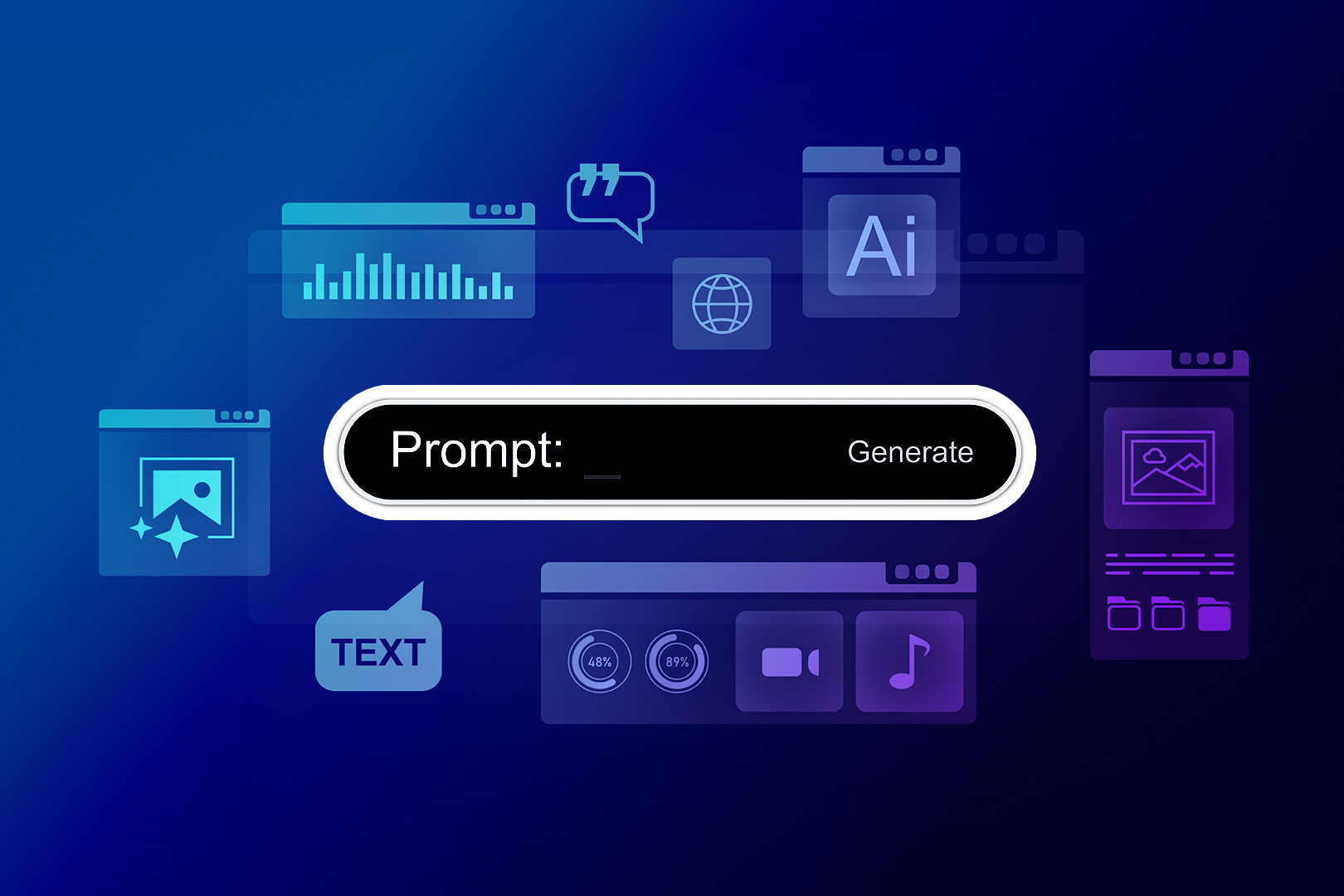Want to know what distinguishes high-quality AI users from those who get lackluster results?
It’s the quality of their prompts.
You can use AI prompts to improve your sales process and save time, but if you’ve struggled to do that so far, you will need a better way to prompt. But you’re in luck. We rounded up some of the most useful, ready-to-use, simple copy-and-paste AI prompts you can put to work as a sales rep today.
What Are AI Prompts (and Why They Matter for Sales)
First, the basics: AI prompts are the directions you type into tools like Claude, ChatGPT, or Close’s AI features.

With AI prompts, if you’re not specific enough, you may end up frustrated with lackluster or off-base outputs. AI is more similar to humans than you might think. Consider asking a friend for advice. You’re more likely to receive a helpful response when you provide clear context and specificity about what you’re seeking.
That’s why having clear, specific, task-oriented prompts will work within AI’s current capabilities. With a good prompt, you’re not asking AI to do anything it can’t handle.
Let AI do what AI does well (like digesting an enormous amount of information from a transcript in a few seconds) and then tell it what you need distilled from that information.
The bottom line: AI is here to assist you, not replace you. But that assistance works best when you know how to prompt it.
To illustrate this, we’ve shared some specific prompts that you can use and organized them into categories where AI excels.
30 AI Prompts Every Sales Rep Should Bookmark
Quick note before we get into the prompts themselves: Each of these prompts should include scene-setting context for the LLM before you copy and paste these customized prompts into your tool of choosing.
For example, preface your prompt with something like: "Write as if you are a seller at XYX company that sells [blank]", as well as any other relevant details that are pertinent to your ICP or selling process. This will help ensure you spend less time fine-tuning your outputs.
Prospecting & Research Prompts
Gathering background information on a prospect can be time-consuming and inefficient without AI. You have to scrape through their social media presence and various websites and start making guesses—and that’s assuming you have their information at all.
Summarize a lead’s website and/or LinkedIn to find a personalized opener.
- Prompt: Analyze [prospect's name, role, at XYZ company] online presence to craft a personalized opening line that shows a genuine understanding of their business or role.
Identify the pain point this buyer cares about most.
- Prompt: Review [prospect’s] industry, responsibilities, and recent activity to pinpoint their most likely challenge or pain point.
Generate a short icebreaker that connects the prospect’s background to your solution.
- Prompt: Review [prospect’s] LinkedIn summary and recent posts to craft a one-sentence icebreaker that connects their background or achievements to how [product] could help them succeed.
Summarize the last six months of company news to find a relevant hook.
- Prompt: Analyze recent press releases, blog posts, and LinkedIn updates from [company name] over the past six months. Summarize the top 2–3 themes or milestones, then suggest one conversational hook that links their current priorities to how [your product] can help.
Analyze this prospect’s tech stack and suggest how our tool could fit in.
- Prompt: Review [prospect’s] website, product listings, and LinkedIn to identify tools in their current tech stack. Summarize what each tool is used for, note any overlaps or gaps, and explain (in 2–3 sentences) how [your product] could complement or replace part of their existing setup to streamline their workflow.
Outreach & Email Prompts
The cold intro. Sometimes it feels like sticking your hand out for a handshake with no idea what’s going to come next. It’s not comfortable. And given that each cold email needs to uniquely address each recipient, it’s a process that’s notoriously hard to scale (without sacrificing quality).
Generative AI may not always be great at pulling off the “human touch” with its sales outreach, but with the right prompting, you’d be surprised how helpful it can be.
Write a 3-line cold email in a consultative tone for [persona].
- Prompt: Act as an Account Executive at [your company]. Write a three-sentence cold email for a [persona: e.g., VP of Sales at a SaaS company] who’s struggling with [pain point]. The tone should be friendly, consultative, and focused on understanding their challenges, not pushing a hard sell. End with a low-pressure CTA to start a conversation.
Rewrite an email to sound warmer and more conversational.
- Prompt: Rewrite the email below to sound more natural and human, using shorter sentences, simpler words, and a tone that feels like a peer offering help, not a brand making a pitch. Maintain clarity and professionalism, but drop all corporate jargon. [Note: don’t forget to paste your email in here!]
Create three subject line options to emphasize ROI or urgency.
- Prompt: Generate three concise subject line options for the following email. Each should highlight either the return on investment or the cost of waiting, while staying under 8 words and sounding conversational rather than clickbaity.
Draft a short follow-up email for a prospect who clicked but didn’t reply.
- Prompt: Write a short, polite follow-up email (3–4 sentences) to a prospect who opened or clicked the last outreach but didn’t respond. Acknowledge their interest, restate the value briefly, and include a soft CTA that makes it easy for them to re-engage.
Personalize an outreach email using details from a company’s latest announcement.
- Prompt: Review [company name]’s latest press release or LinkedIn announcement and summarize the main takeaway. Then, rewrite the outreach email below to connect our product’s value directly to that news, showing we’re paying attention to what matters most to them right now.
Follow-Up Prompts
You might imagine that a “just checking in” follow-up is something only a human can handle. And yes, you’ll want to thread a needle here: something that’s not too pushy, not too cold or analytical, and just the right amount of “polite.” Here are some ways to have AI generate ideas for you.
Draft a “just checking in” message that doesn’t sound pushy.
- Prompt: Write a brief, friendly follow-up email to a prospect I haven’t heard from in a week. Keep it under four sentences, avoid any “just following up” phrasing, and instead reframe it as checking alignment or offering help. End with a clear, low-pressure next step.
Summarize our last call and suggest next steps.
- Prompt: Summarize the key points from this call transcript [paste transcript or notes]. Include what the prospect shared, their main challenges, and the agreed-upon next step. End with a short paragraph I can paste into an email to confirm alignment and momentum.
Write a polite “breakup” email that leaves the door open to future opportunities.
- Prompt: Write a short, polite breakup email for a prospect who hasn’t responded after several attempts. Keep the tone respectful and light, acknowledge that now might not be the right time, and close with a one-line invitation to reconnect when priorities shift.
Create a one-line re-engagement message for a prospect who ghosted.
- Prompt: This client recently “ghosted” me. Draft a single-sentence message I can send via email or LinkedIn to re-engage them. Make the message curious, not needy, ensuring it invites a reply by referencing their goals or the original value we discussed.
Write a friendly nudge email referencing the value we discussed last time.
- Prompt: Write a short follow-up email (up to three sentences maximum) referencing a specific pain point or ROI we discussed with this prospect in our last conversation. Make it sound friendly and helpful, not pushy. Include a simple CTA at the end, phrased in the form of a yes/no question, to help things move forward.
Call Prep & Meeting Prompts
AI is great at summary, and that’s perfect if you’ve got a meeting in ten minutes and need a quick recap of what’s important to the prospect you’re calling. You can also use AI as a sparring partner, having it generate likely objections to your offering so you know what to say if those issues arise.
Create a quick pre-call brief with key facts about [company].
- Prompt: Research [company name] and summarize 5–6 key facts I should know before a sales call. Include their size, industry, recent announcements, tech stack, and one potential challenge our product could help with. Format it as a short, skimmable pre-call brief so I can review it in the next ten minutes.
Generate 5 discovery questions for a [title] in [industry].
- Prompt: Write five thoughtful, open-ended discovery questions I can ask a [title, e.g., VP of Operations] in the [industry] industry to uncover pain points and priorities related to [problem area].
Summarize likely objections and how to handle them.
- Prompt: I have a call coming up with [name / position / industry]. Based on common challenges in [industry or persona type], list 3–5 objections I’m likely to hear during a sales conversation about [product or feature]. For each objection, include a short, confident response or reframe I can use in real time.
Draft a short opening line to build rapport at the start of a call.
- Prompt: Write 3 casual, natural-sounding opening lines I can use to start a sales call. Each should make a quick personal or situational connection (like referencing a recent event, shared contact, or their role) without sounding forced or scripted.
Suggest 3 cross-sell or upsell opportunities for an existing customer.
- Prompt: Review this customer’s account data [paste key details or products used] and suggest three logical cross-sell or upsell opportunities based on their current setup, usage trends, and business goals. Include one sentence explaining why each recommendation fits.
Pipeline & Forecasting Prompts
Checking your sales pipeline for “cracks” or “leaks” used to be a monotonous task. And even when you checked it yourself, there’s always the possibility that you missed something as your eyes glazed over.
You can put AI to use in your CRM by having it analyze your data and look for trends in your sales quarter you wouldn’t have spotted yourself. Think of it as a more objective pattern-recognition service.
The key? Using highly-specific prompts that prevent “AI hallucination” and return cold, hard data insights.
Summarize a pipeline by deal stage and identify stuck opportunities.
- Prompt: Review my pipeline data and summarize deals by stage. Highlight which ones are stalled, if any, and why, using notes or last-touch activity as context.
Suggest 3 deals worth re-engaging based on last activity.
- Prompt: Analyze my recent deal history over the previous [insert date range here] and suggest three accounts that show re-engagement potential based on timing, behavior, or past interest.
Draft a short note to update my manager on this account’s status.
- Prompt: Summarize the current status of [account name] in 3–4 sentences. With each, note what’s been done, where things stand, and what the next step should be.
Identify trends in my closed-won vs. lost deals this quarter.
- Prompt: Compare my closed-won and closed-lost deals from this quarter and identify common patterns in buyer type, deal size, or objections. Using this data, what would you identify as the pattern of my top-performing deals?
Predict which active deals have the highest likelihood to close based on recent activity.
- Prompt: Review all open deals and rank them by likelihood of closing soon, based on the recency of engagement, deal stage, and sentiment in notes.
Coaching & Self-Improvement Prompts
AI can’t make the sale for you. But it can help you make more sales by looking for patterns in your sales: why you lose them, where your tone is off, or looking for patterns in your top-performing emails that you wouldn’t have otherwise noticed.
Summarize a recent call transcript to highlight improvements.
- Prompt: Review this call transcript and summarize my talk-to-listen ratio, key strengths, and one or two areas I could improve next time.
Rewrite a pitch for clarity or tone.
- Prompt: Take this pitch and rewrite it to sound clearer, more confident, and conversational. Keep the same points, but tighten the delivery.
Identify patterns in my top-performing emails.
- Prompt: Analyze my highest-reply emails and summarize what they have in common: tone, structure, subject lines, or message length.
Suggest 3 ways to make my discovery questions more open-ended.
- Prompt: Review these discovery questions and rewrite or expand them to invite deeper responses and uncover more detailed insights.
Analyze feedback from my last five calls and suggest one specific area to practice.
- Prompt: Read through these five call summaries or notes and identify one recurring theme or skill gap I should focus on improving.
Turning Prompts into a Sales Advantage
Got a prompt that’s worked wonders for you here? Save them in your Close CRM or within Notion. It’ll be a bit like a football coach’s playsheet: when you have a favorite that keeps working for you, you want it by your side at all times.
That’s not all AI can do, of course. Check out some of our recent posts on the power of AI in your CRM to help you make sales:
- SDRs de IA: ¿Funcionan realmente?
- The Best AI Outreach Tools
- AI Content Marketing: 10X Your Process with These Tips
Ready to start experimenting with some prompts? Drop a few of these into your CRM today to watch your time-to-close shrink.












